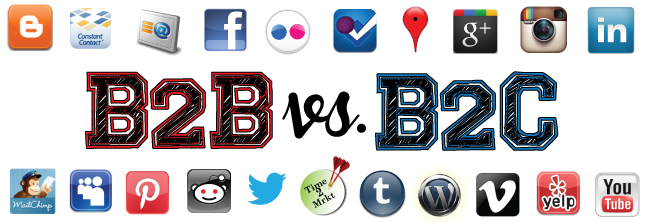Which type of business do you have?
 First, consider whether a business is B2B – Business to Business, or B2C – Business to Consumer. The difference is which tools used in a marketing effort, especially if they are on a limited time or money budget. After that determination, look at how the tools used interact with the website and the other marketing components.
First, consider whether a business is B2B – Business to Business, or B2C – Business to Consumer. The difference is which tools used in a marketing effort, especially if they are on a limited time or money budget. After that determination, look at how the tools used interact with the website and the other marketing components.
All business, whether they are a mom and pop spot or a Fortune 50 company have the same goals when using social media:
- Brand Awareness – making sure that customers and potential customers recognize your brand – what you provide and what your brand represents.
- Thought Leadership – customers want to feel like they are getting an authority in their field whether it is a plumber or an HR representative.
- Sales or Lead Generation – everyone needs new customers. If you are using social media to reach out to them, you need to track the flow of contact to contract.
- Customer Support or Advocacy – this is when help desk support is provided through social media. Depending upon your business, it may require 24/7 responsiveness.
There are over 1000 digital properties that you can use for your business. Some are more appropriate than others. My preference is to start with the most common ones and branch out from there. Let’s talk about my top 10 and for which type of business they are best suited:
- Blogs – is short for weblog. This is where we get to share our thought leadership. If you are strapped for time, this is the one thing that I recommend you do. Regular new content bring the search bots back to your website on a regular basis. Slight edge to B2B for this tool.
- LinkedIn – if you are in business you need a LinkedIn personal account. Create a Company account for your business, which requires an email address at your domain name. Just another reason why you need a professional email address. The edge goes to B2B on this as well.
- Facebook – is very definitely B2C, although many B2B business like my own can benefit from a regular presence on Facebook. Pictures and videos win on this platform. Offer rewards to customers who check-in or tag your business in one of their posts.
- Twitter – is limited to 140 characters at a time. This is a great customer service tool. Many businesses alert their customers to specials of the day. Tie between B2B and B2C.
- YouTube – is the 2nd largest search tool and it isn’t even a search engine. 4 billion searches a day, do I need to say more. This is a win for B2B with product demonstrations and how-to’s.
- G+ – provides an edge on Google search results. It works like Facebook but not as many regular users. Worth investigating for B2B and B2C.
- Photo sites – Instagram is the big player in this arena. Very definitely B2C with all the clothes, food and check-ins that happen with these types of platforms. Think about other platforms like Flickr and Picasso.
- Pinterest – gets its own category as both areas can link to things on their websites, especially if you include an image in a blog post, then pin the image. This is a win for B2C.
- Location sites – include Yelp, Bing places, Yahoo, Foursquare and the like. Even if you don’t have a storefront location, you may want to “claim” your business on a few of the appropriate sites. Winner again is B2C.
- Emails – while this is not a social platform, it is social. People read more emails now because of smart phones. Don’t over send and make what you send worth reading. B2B and B2C.
Those are my top picks. How did you do on the comparison of B2B vs. B2C. You don’t have to use them all at once. Try working with one and then expand. Make sure to track incoming calls to know which ones are working best for you!
Pingback: Women in Business Group Learns About Business to B2B and B2C Marketing | Grundy County Chamber of Commerce